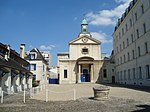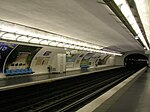Michel Bizot (Paris Métro)
Paris Métro line 8Paris Métro stations in the 12th arrondissement of ParisParis Métro stubsRailway stations in France opened in 1931

Michel Bizot (French pronunciation: [miʃɛl bizo]) is a station on line 8 of the Paris Métro, named after the Avenue du Général Michel Bizot. The station opened on 5 May 1931 with the extension of the line from Richelieu–Drouot to Porte de Charenton. The Avenue du Général Michel Bizot takes its name from the French military engineer General Michel Brice Bizot (1795-1855), fatally shot at the siege of Sevastopol during the Crimean War. Nearby is the Promenade Plantée—a 4.5 km long elevated garden along the abandoned railway which led to the former Gare de La Bastille railway station.
Excerpt from the Wikipedia article Michel Bizot (Paris Métro) (License: CC BY-SA 3.0, Authors, Images).Michel Bizot (Paris Métro)
Avenue Daumesnil, Paris 12th Arrondissement (Paris)
Geographical coordinates (GPS) Address Nearby Places Show on map
Geographical coordinates (GPS)
| Latitude | Longitude |
|---|---|
| N 48.837485 ° | E 2.401234 ° |
Address
Aux Contes de Fées
Avenue Daumesnil
75012 Paris, 12th Arrondissement (Paris)
Ile-de-France, France
Open on Google Maps









